What is Pharynx, Parts, Function, Disease, Cure, And Facts
What is Pharynx?
Do you know about a body organ which serves as an integral part of the two major body systems at the same time? Here you will learn What is Pharynx and a detailed and deep analysis of its structure, anatomy, facts, functions, diseases and other prominent features of this organ of the body.
As described by Frank Weaker (2013), the pharynx is a shared passageway of the digestive and respiratory systems.It is positioned above the esophagus and larynx and behind the mouth and the nasal cavity.This semi-muscular tube connects the mouth to the esophagus and the nasal cavity to the windpipe or trachea.The larynx and the esophagus are the tubes, leading down to the lungs and the stomach, respectively.
Pharynx, as a shared respiratory and digestive system organ, is found in both the invertebrate and vertebrate animals. However, its structure is not universally the same in all the animal species across the world.
Structurally, the pharynx has three subdivisions with clear boundaries separating one from the other. These parts are called the nasopharynx, the oropharynx and the laryngeal pharynx or laryngopharynx. Air from the nose and food and fluids from the mouth have to cross the paths in the pharynx to get entry into trachea and the esophagus, respectively.
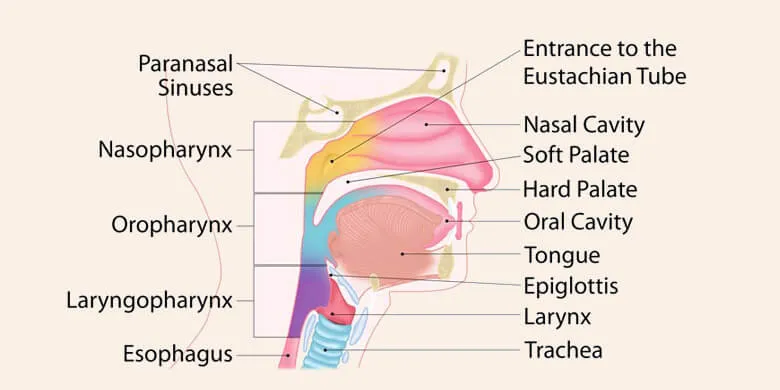
Fig. 1: What is Pharynx
Table of Contents
In his book “Motor Function of the Pharynx, Esophagus, and Its Sphincters”, Ravinder K. Mittal (2012) provides comprehensive explanation of the role of the pharynx as the swallow structure and the breathing structure. According to him, it is in contact with as many as four different cavities, namely, oral, nasal, laryngeal and esophagus.The two major functions served by the pharynx are to assist in swallowing and breathing.
Upon swallowing or deglutition, the pharynx switches its role from a breathing organ to a swallow organ. During the act of swallowing, there is the closure of the palate and the laryngeal inlet. You can divide swallow into four distinct phases, namely, preparatory, oral, pharyngeal and the esophageal.
The pharynx is susceptible to bacterial and fungal or viral infections and other disorders of mild and serious nature. According to A. L. Baert (2012), the author of the “Radiology of Pharynx and the Esophagus”, there exists a close relationship between the diseases of pharynx, esophagus (food pipe) and larynx.While explaining it, he says that the gastrointestinal disorders, like the reflux disease, are very likely to show extraesophageal manifestations in the pharynx and larynx. Likewise, additional simultaneous tumors may be formed in the pharynx region in case of tumors occurring in the esophagus or the upper aerodigestive tract.
Successful treatment of pharynx disorders depends on the timely and accurate diagnosis of the condition and use of appropriate therapy.
Pharynx Parts
Measuring around 12 to 14 cm in its vertical length, the larynx can be seen as an extension from the base of the skull to the upper boundary of the UES or upper esophageal sphincter. Structurally, the pharynx can be divided into three main parts. As described by F. Weaker (2013), the three distinct subdivisions of the pharynx include the nasopharynx, the oropharynx and the laryngeal pharynx. These pharynx parts enable it to make and maintain a connection with 4 different cavities of larynx, nose, mouth and esophagus.
Here follows a brief description of the structure and function of the pharynx parts.
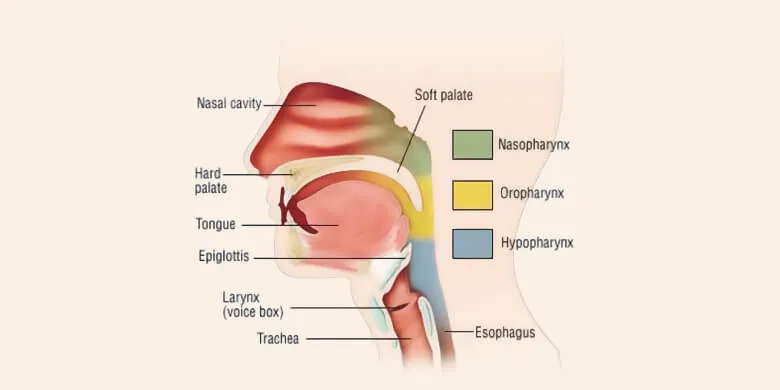
Fig. 3: Pharynx Parts.
- Nasopharynx
- Oropharynx
- Laryngeal Pharynx
- Passageway for Food
- Passageway for Inhaled Air
- Speech Production
- Warming and Humidification
- Role in Taste
- Hearing
- Sample Air for Antigens
- Production of Antibodies
- Pharyngitis
- Symptoms/Diagnosis
- Difficulty and pain on swallowing the food bolus.
- Myalgia or pain in the pharynx muscles.
- Abdominal pain and vomiting, experienced rarely by adults and more frequently be children.
- Inflammation of the tonsils, that is, tonsillar swelling.
- Pharyngeal or tonsillar exudates accompanied by pharyngeal erythema.
- Fever with temperature exceeding 101 0F.
- White blood cell count of less than 10,000.
- Treatment
The first segment of the pharynx is called the nasopharynx. It starts at the base of the skull and continues to the soft palate. The segment derives its name from its connection with the nose or nasal cavity (Mittal, 2012).
Regarding nasopharynx location, it is found posterior to the nasal cavities. Though a tubular structure, only posterior wall of the nasopharynx is muscular, i.e. formed by muscle. The anterior wall has two choanae or openings which connect the nasopharynx with the nasal cavity.
Posterior to the choana and along the superior nasopharyngeal wall, there are the pharyngeal tonsils. The job of the tonsils is to sample the inhaled air for foreign substances or antigens. In case of swelling or inflammation, these structuresare described asadenoids. There is degeneration of the pharyngeal tonsils with age.
As the very name suggests, the oropharynx is that subdivision of the pharynx which connects it with the mouth or oral cavity. The location of oropharynx can be traced to the posterior of the oral cavity. It extends from the soft palate and continues to the pharyngoepiglottic fold (Mittal, 2012).
So, it is the soft palate which separates the nasopharynx from the oropharynx. On the other hand, the epiglottis serves as a separation between the oropharynx and the laryngeal pharynx or laryngopharynx.
Looking at its anterior, you will come across two folds of oral mucosa which have been separated by the palatine tonsils. As these folds look like a pillar or a column, many clinicians are inclined to call them anterior and posterior tonsillar pillars. However, anatomically, they are referred to as the palatoglossal and the palatopharyngeal folds.
The laryngeal pharynx or laryngopharynx has also been named as hypopharynx by Mittal (2012). The laryngopharynx derives its name from its connection with the larynx or the voice box. This segment extends from the pharyngoepiglottic fold to the upper border of the UES (Upper Esophageal Sphincter).
Located posterior to the larynx or voice box, the laryngopharynx consists of the structures, like epiglottis, aryepiglottic folds and piriform recess. Here it is also to be noted that the boundaries between the larynx and the laryngopharynx are shared.
The epiglottis is made up of the epiglottic cartilage. With the help of a sheet of connective tissue, this epiglottic cartilage is attached inferiorly to the cricoid cartilage. Meanwhile, the cartilage of epiglottis also extends superiorly to serve as a protective lid for the opening of the larynx or glottis.
The aryepiglottic fold is the fold of the mucosa which serves as a covering for the free edge of the connective sheet which connects epiglottis to two small cartilages, called arytenoid cartilages. The aryepiglottic folds, extending from the arytenoid cartilage to the epiglottis, laterally bind the superior aperture of the larynx or voice apparatus of your body.
Located inferior to the aryepiglottic folds, you can find a lateral expansion of the laryngopharynx which is called the piriform recess.
Pharynx Anatomy
The pharynx anatomy is not that much difficult to understand. Though a part of the interior wall is formed by epiglottis, corniculate, cuneiform, arytenoid and cricoid cartilage, the pharynx is primarily a muscular structure. There are thyroid and hyoid bones which serve the job of providing attachment to some of the muscles of the organ.
You can broadly view the pharynx muscles as intrinsic and extrinsic.
The intrinsic muscles constitute the inferior, middle and superior constrictor muscles along with the horizontal (cricopharyngeus) and oblique (thyropharyngeus) fibers. A triangular area, called the Killian’s triangle, exists between the horizontal and oblique muscle fibers. It is composed of the relatively scanty muscle fibers. This area is the site of Zenker diverticulum which can be seen in patients suffering from difficulty in swallowing caused by impaired relaxation or opening of the upper esophageal sphincter.
The extrinsic muscles can be divided into three subgroups. The muscles in Group 1 are the elevators and tensors of palate. Those in Group 2 are responsible for causing anterior and superior displacement of the larynx during the process of swallowing. On the other hand, the extrinsic muscles in Group 3 are concerned with the closure of laryngeal inlet. They include thyroarytenoids, aryepiglottis and oblique arytenoids muscles. The extrinsic muscles of the pharynx are supplied by different branches of the cranial nerves.
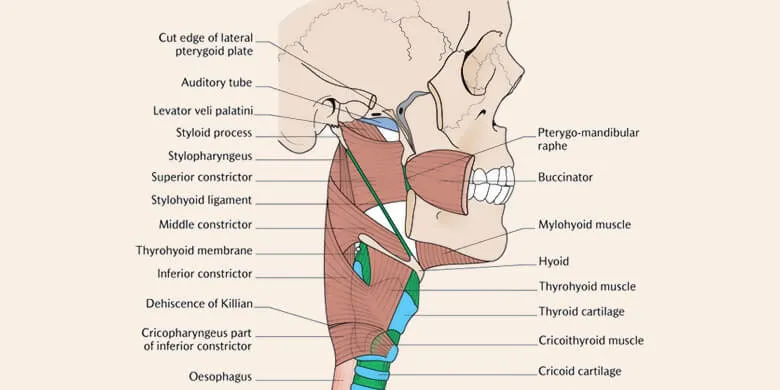
Fig. 3: Image of Pharynx Anatomy
The nerve-muscle fiber innervation ratio of 1:2 to 1:6 is indicative of the fact that the pharyngeal muscles are richly innervated. On the other hand, this ratio for the human gastrocnemius muscle and extraocular eyes musclesis 1:2000 and 1:9, respectively. Here it should be noted that the rich innervation is essential for the “fine” control required for the pharynx function.
With the help of a lateral radiograph of the region of oropharynx, it can be seen that there is a column of air in the oropharynx as well as nasopharynx and the upper part of the laryngopharynx up to the lower boundary of the laryngeal opening.
Formed by the posterior nasal aperture, tongue, oral cavity, laryngeal vestibule, epiglottis, posterior surface of the cricoid cartilage, valleculae and soft palate, the anterior wall of pharynx appears to be irregular in structure. However, the posterior pharyngeal wall shows a significant level of smoothness.
Pharynx Function
As a shared organ of the digestive and respiratory system, the pharynx assists both the major body system in the execution of their essential functions. At the same time, it also plays its role in hearing and speech.
In their book, “Ross & Wilson Anatomy and Physiology in Health and Illness”, Waugh and Grant (2010)describe as many as seven important functions of the pharynx. The major pharynx functions are briefly discussed below:
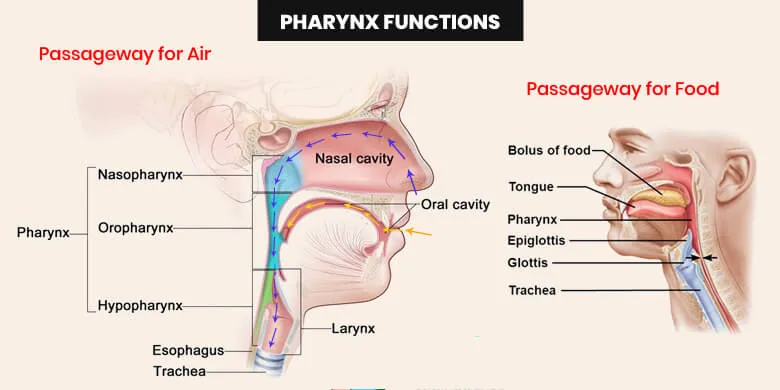
Fig. 4: Image of all Function of Pharynx
The role of the pharynx as a digestive organ is to serves as a passageway for the food which has been masticated and turned into a bolus in the mouth or oral cavity. After passing through the oral (oropharynx) and laryngeal (laryngopharynx) sections, the food is pushed down to the esophagus or food pipe.
Oral, pharyngeal and esophageal are the three phases of normal swallowing. In the oral phase, the food is chewed and converted to bolus which is then passed to the pharyngeal region under voluntary control. In the pharyngeal phase of swallowing, the nasopharynx is closed to prevent the food from entering into the nasal passages. In the third esophageal phase, the food bolus moves through the esophagus and lower esophageal sphincter to reach the stomach.
Performing its role as a respiratory organ, the pharynx assists in the passage of inhaled air from the nasal and oral cavities. The air then enters the trachea or windpipe to reach the major respiratory organs, the lungs.
The pharynx acts as a resonating chamber for the sound produced in the larynx or sound apparatus. So, while working in coordination with sinuses, it helps to give your voice unique or individual characteristics.
While passing through the nose, the air is warmed and moistened. The inhaled air is further warmed and humidified as it passes through the pharyngeal region.
It also plays a role in the sense of taste. Actually, the epithelium of the oral and pharyngeal parts has olfactory nerve endings which assist in the sense of taste.
The air enters the middle ear with the help of the auditory tubes which extend from nasopharynx to each middle ear. It is the presence of the air at atmospheric pressure on each side of the tympanic membrane that you can ensure satisfactory hearing. So, as a passageway for air, the pharynx assists the sense of hearing.
There are pharyngeal tonsils, located to the posterior of the choana (nasopharyngeal opening) and along the superior wall of the nasopharynx. The job of these structures is to sample the inhaled air for the foreign substances or antigens.
In other words, the pharynx plays a role in the purification of the air.In response to the presence of antigens, like bacteria, antibodies are produced in the laryngeal and pharyngeal tonsils. It indicates the role of Pharynx in the defense system of your body. The tonsils are larger in children and tend to degenerate with the passage of time.
Pharynx Diseases
Since the hollow tubular structure of the pharynx is connected with oral as well as nasal cavities, it may be affected by the disease-causing agents which are present in the ingested food or the inhaled air. These disease-causing agents may give rise to pharyngeal disorders or infections.
On the other hand, an infection or disease of the pharyngeal region may totally or partially impair several different functions performed by this organ, including ingestion of food, inhalation of air, production and quality of speech, creation of antigens and the senses of smell and hearing.
Common disorders of pharynx include pharyngitis, tonsillitis, pharyngeal cancer and adenoids hypertrophy.
Some of the pharyngeal disorders are being described as under along with symptoms and the commonly recommended treatment methodology.
Pharyngitis is of different types and its severity may vary based on the nature of the causative agent. Pharyngitis caused by streptococcus pyogenes is one of the most common and controversial issues faced by the clinicians on daily basis.
Streptococcus pyogenes is a Group A hemolytic streptococcus.The patients sufferingfrom acute illness also pose the risk of the potential spread of the organism (germ) to affect other individuals.
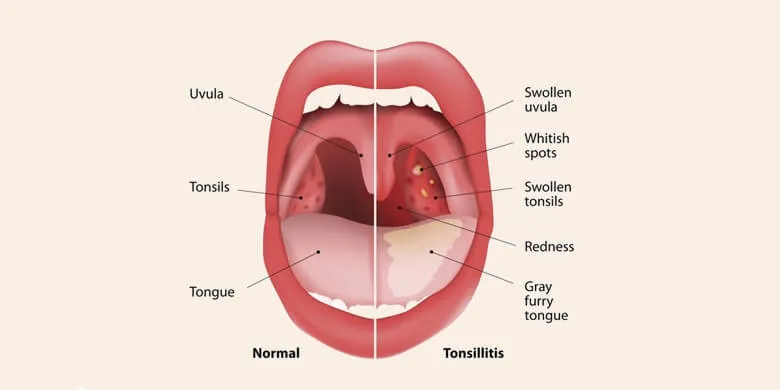
Fig. 5:
The gram-positive coccus, responsible for pharyngitis, grows in chains and may also cause other infections, like tonsillitis, erysipelas, cellulitis, rheumatic fever, scarlet fever, lymphangitis, myonecrosis and necrotizing fasciitis, etc.
The clinical manifestations of streptococcal pharyngitis are quite similar in both the children and adults. In their book Streptococcal pharyngitis: optimal management, Pechere et al (2004)lists following symptoms for this condition of the pharynx:
As claimed by Domino (2010), the choice of effective medication depends upon the type and nature of the causative agent which may be a virus or a bacterium. However, an empiric therapy should be avoided as it may lead to overuse of antibiotics in adults.
Penicillin is considered a standard therapy for the treatment of the streptococcus pharyngitis. This medication has shown effectiveness also for the cure of rheumatic fever. The recommended dosage may vary from 250 mg to 500 mg.
The additional treatment measures include salt water gargles and the use of acetaminophen. Intake of acetaminophen every four hours may give more rapid relief than antibiotic therapy for the streptococcus infection.
Bertorini (2010), in the book “Neuromuscular Disorders: Management and Treatment E-Book”, talks in detail about the nature, pathogenesis, clinical manifestations, diagnosis, treatment and management of dysphagia. According to him, dysphagia or impairment of deglutition is one of the most disabling conditions which arise from the neuromuscular disorders and cause high morbidity, mortality and cost. The condition typically refers to difficulty in eating, resulting from disruption in the process of swallowing.
Dysphagia can be of two types, that is, esophageal or oropharyngeal. Here our focus shall be on the oropharyngeal type of dysphagia. Also known as transfer dysphagia, the oropharyngeal dysphagia results from the diseases which affect the functioning of the larynx, oropharynx and upper esophageal sphincter (UES).
The most common underlying causes of transfer dysphagia include oropharyngeal tumors as well as myogenic and neurogenic disorders.The oropharyngeal dysphagia is likely to result from the abnormalities in the oral or pharyngeal phases of swallowing food. A neuromuscular disease can cause disruption or failure of the process of swallowing.
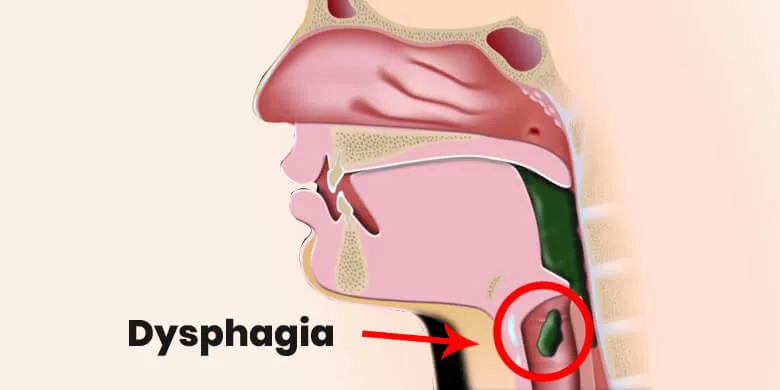
Fig. 6:image of Dysphagia
According to Bertorini (2010), individuals suffering from dysphagia may complain of either inability to swallow food or choking on solids. However, there are other symptoms as well. The commonly observed symptoms of dysphagia include:
- Pain or difficulty in swallowing.
- Patients complain of choking on solids.
- Coughing and nasal regurgitation.
- Dysarthria is also suggestive of oropharyngeal dysphagia.
For the objective measurement of difficulty in swallowing, an oropharyngeal examination may be carried out by a speech pathologist. Modified barium swallow with videofluoroscopy may also be used.In videofluoroscopy, the patient is asked to swallow a barium suspension of varying consistency, which may be in fluid or semisolid form. Meanwhile, the analysis of various stages of swallowing is conducted for the accurate diagnosis of the condition.
As suggested by Bertorini (2010), coaching by a speech pathologist and modification of food and fluid consistency should be recommended for the initial management of dysphagia. It is particularly because, the use of thicker liquids and semisolid foods with a high water content, like gelatin, are helpful in the alleviation of aspiration.Meanwhile, drinking through straws can also help with swallowing.
In case of the failure of initial measures, an alternative route for nutrition, like enteral nutrition, is warranted. It can be achieved by the use of a nasoenteric or nasogastric tube. It may also involve the use of a percutaneous endoscopic gastrotomy (PEG) tube but it may involve the high risk of complications due to associated comorbidity.
Pharyngeal Cancers
According to the findings of the American Cancer Society (2018), the oral and pharyngeal cancers account for around 443,000 (or 3%) cancer cases and 241,000 deaths worldwide. The cancer of oral cavity is the most commonly diagnosed type of cancer in men in India.
The causes of oral and pharyngeal cancers include alcohol consumption, cigarette smoking and chewing tobacco or betel quid.
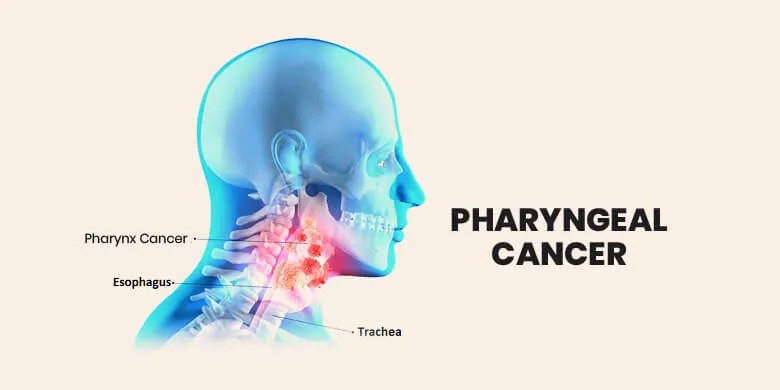
Fig. 7: Image of Pharyngeal Cancers
Salvo (2017) describes pharyngeal cancers as the development of malignant tumors in the pharynx. The oral cancers, on the other hand, are characterized by the malignant tumors inside the oral cavity or on the lips.
In most of the cases, the pharyngeal cancer isthe squamous cell carcinoma which is a type of skin cancer.
In the book “Mosby's Pathology for Massage Therapists”, Salvo (2017) talks about the signs and symptoms of oral and pharyngeal cancers. The average age for the diagnosis of the pharyngeal cancer is 55 to 60.
Unfortunately, majority of people with pharyngeal or oral cancer are diagnosed when the condition has advanced. It is because the cancerous lesions tend to be hidden as well as painless.
There is also the likelihood that these cancers will metastasize to local lymph nodes.
The obvious signs and symptoms of oral and pharyngeal cancers include:
- Appearance of whitish thickened areas which may develop into either nodular masses or ulcerated lesions.
- Numbness of the tongue or some other part in the oral or pharyngeal regions.
- Patients experience halitosis or bad breath.
- Poor denture fit and loosening of teeth.
- Pain or difficulty in swallowing.
- Sore throat and changes in the voice.
- Weight loss and enlarged cervical lymph nodes.
As the use of tobacco and excessive consumption of alcohol are the major causes of the pharyngeal cancer, the best prevention method is the reduction of such risk factors.
Salvo (2017) suggests the use of surgery or radiation or both for the treatment of small and medium size tumors. On the other hand, extensive surgery is used for the removal of large tumors. In the process, the involved lymph nodes of the lymphatic system are also removed. It may be followed by postoperative radiation therapy.
In case the tumors are inoperable, radiation therapy may be used in combination with chemotherapy.
Amazing Pharynx Facts
- Do you know your pharynx has also got a role to play in the sense of taste? And the tongue is not the only organ of taste.
- The pharynx helps in the sense of taste with the help of the olfactory nerve endings found in the oral and pharyngeal parts.
- Interestingly, two small arytenoid cartilages which are connected to epiglottis (a part of the laryngeal pharynx) look like two birds.
- How does your voice get individual characteristics? Actually, working as a resonating chamber for the sound produced in the voice box, the pharynx makes your voice unique.
- It acts as an organ of defense by producing antibodies in response to the entry of antigens.
- You can effortlessly perform the oral, pharyngeal and esophageal phases of normal swallowing up to 600 times a day!
- Do you know 26 groups of muscles and five cranial nerves are involved in successfully coordinating the act of swallowing?
- According to the findings of the American Cancer Society, the pharyngeal and oral cancers account for about 3% of cancer cases in the world.
- It is shocking to note that 65% cases of oral and pharyngeal cancers occur in the developed countries.
- Oral and pharyngeal cancers are responsible for around 241,000 worldwide.
- Do you know which is the most commonly diagnosed cancer in men in India? It is the cancer of oral cavity.
- Men affected with oral and pharyngeal cancer outnumber women approximately 2:1.
- Weaker, F. (2013). Structures of the Head and Neck. FA Davis.
- Mittal, R. K. (2012). Motor function of the pharynx, the esophagus, and its sphincters. In Physiology of the Gastrointestinal Tract (Fifth Edition) (pp).
- Baert, A. L. (2012). Radiology of the Pharynx and the Esophagus. Springer Science & Business Media.
- Waugh, A., & Grant, A. (2010). Ross & Wilson Anatomy and Physiology in Health and Illness E-Book. Elsevier Health Sciences.
- Pechère, J. C., & Kaplan, E. L. (Eds.). (2004). Streptococcal pharyngitis: optimal management (Vol. 3). Karger Medical and Scientific Publishers.
- Domino, F. J. (Ed.). (2010). The 5-minute clinical consult 2011. Lippincott Williams & Wilkins.
- Bertorini, T. E. (2010). Neuromuscular Disorders: Management and Treatment E-Book. Elsevier Health Sciences.
- American Cancer Society (2018). The American Cancer Society's principles of oncology. Hoboken, NJ: Wiley Blackwell.
- Salvo, S. G. (2017). Mosby's Pathology for Massage Therapists-E-Book. Elsevier Health Sciences.


